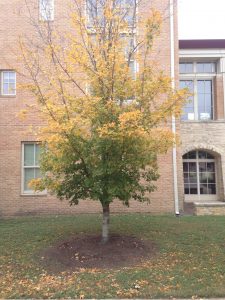By Jackson R. McKeating
For a while, the Bigtooth Maples around campus just weren’t delivering their famously beautiful fall foliage. 2 months of autumn (October, November) saw only minor changes at best. This was seen from a slight yellowish tinge on the end of the leaves of some trees, while other specimens didn’t even have this. Considering that the Bigtooth Maples around campus are technically out of their native range (though not by much), I thought that it wouldn’t get cold enough in Austin to actually set the trees off. However, this recent cold snap, which falls in line with the weather predictions of the Old Farmer’s Almanac (1), has started the world-renowned process. That is, for some of the trees.
Youngest Tree Middle-aged tree Oldest tree
Despite these pictures being taken on the same day, and all three trees being the same species, all three are in different parts of the autumn seasonal cycle.
At first, I wondered if this had something to do with where the trees were planted. The two trees with green leaves are mostly shielded from sunlight and other elements, as they’re right in front of buildings instead of out in the open like the more yellow tree. But while that made sense at first, it doesn’t take into account the fact that the lack of sunlight would actually make that environment colder, which in theory should speed up the process of leaves falling. So that was a bust.
I got to thinking that, instead of the sun, the green trees may be shielded from cold wind. While a lack of sunlight is a large factor in temperature, windchill plays a very large factor in the perception of cold. It would make some degree of sense. When a person is wearing layers of clothes, it makes it harder for cold wind to hit their skin, and thus their brain registers the environment around them as less cold. Maybe a thicker tree trunk/branches would have the same effect, insulating the heartwood so that the tree registers the environment as being warmer than it actually is, leading to more summer-like foliage. It sounds good, but this theory is debunked by the fact that the trees aren’t entirely shielded from every possible direction. Cold wind in Texas generally comes in a south-eastern direction, from the Rockies to the northwest. The building shielding the plants, pointing in a north-easterly direction, accounts for this. But cold wind can still easily come from the north, or northeast, which means those trees will still be exposed.
Then, I realized that the two trees with green leaves are near Dujarie Hall, which makes them both closer to campus and in the lawn. I suspected that, as the school’s faculty worked to care for the lawn with extra water and fertilizers, they enriched the trees accidentally. This would mean that the maple I originally looked at, the one with the least leaves on it, has some kind of mineral deficiency or disease. But this theory doesn’t really hold up, either. Not only did the tree perfectly seem perfectly healthy before it changed color, but Bigtooth Maples are very hardy and disease-resistant trees as well (2).
Finally, I considered the one glaringly obvious detail that was right in front of me; The trees are different sizes, some are more mature than others. Could that affect the process of defoliation?
After doing some research, the answer would appear to be yes. According to the information and observations provided by Texas Parks and Wildlife (3), Bigtooth Maples seem to have a particular pattern when it comes to fall colors. Namely, the younger the tree, the sooner the color change. This fits in very well with my own observation, as the tree color and tree size have a marked descending correlation.
It’s still going to be cold for a while, so I personally can hardly wait to see that beautiful golden yellow on a larger scale in the near future.
Sources:
(1) Almanac, O. F. (n.d.). 2018 Long Range Weather Forecast for Texas-Oklahoma. Retrieved December 08, 2017, from https://www.almanac.com/weather/longrange/region/us/11
(2) Want vibrant fall color? Choose bigtooth maple. (2016, May 04). Retrieved December 08, 2017, from https://www.dallasnews.com/life/gardening/2016/05/04/want-vibrant-fall-color-choose-bigtooth-maple
(3) Lost Maples State Natural Area. (2017, November 29). Retrieved December 08, 2017, from https://tpwd.texas.gov/state-parks/lost-maples/foliage-reports


